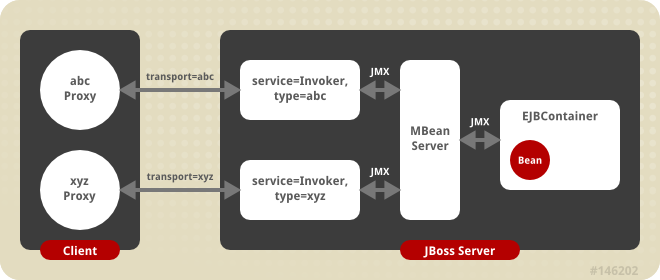Este contenido no está disponible en el idioma seleccionado.
30.2. The EJB Server Side View
Every EJB invocation must end up at a server hosted EJB container. In this section we will look at how invocations are transported to the server VM and find their way to the EJB container via the JMX bus.
30.2.1. Detached Invokers - The Transport Middlemen
Copiar enlaceEnlace copiado en el portapapeles!
We looked at the detached invoker architecture in the context of exposing RMI compatible interfaces of MBean services earlier. Here we will look at how detached invokers are used to expose the EJB container home and bean interfaces to clients. The generic view of the invoker architecture is presented in Figure 30.3, “The transport invoker server side architecture”.
Figure 30.3. The transport invoker server side architecture
For each type of home proxy there is a binding to an invoker and its associated transport protocol. A container may have multiple invocation protocols active simultaneously. In the
jboss.xml file, an invoker-proxy-binding-name maps to an invoker-proxy-binding/name element. At the container-configuration level this specifies the default invoker that will be used for EJBs deployed to the container. At the bean level, the invoker-bindings specify one or more invokers to use with the EJB container MBean.
When one specifies multiple invokers for a given EJB deployment, the home proxy must be given a unique JNDI binding location. This is specified by the
invoker/jndi-name element value. Another issue when multiple invokers exist for an EJB is how to handle remote homes or interfaces obtained when the EJB calls other beans. Any such interfaces need to use the same invoker used to call the outer EJB in order for the resulting remote homes and interfaces to be compatible with the proxy the client has initiated the call through. The invoker/ejb-ref elements allow one to map from a protocol independent ENC ejb-ref to the home proxy binding for ejb-ref target EJB home that matches the referencing invoker type.
An example of using a custom
JRMPInvoker MBean that enables compressed sockets for session beans can be found in the org.jboss.test.jrmp package of the testsuite. The following example illustrates the custom JRMPInvoker configuration and its mapping to a stateless session bean.
Here the default
JRMPInvoker has been customized to bind to port 4445 and to use custom socket factories that enable compression at the transport level.
The
StatelessSession EJB invoker-bindings settings specify that the stateless-compression-invoker will be used with the home interface bound under the JNDI name jrmp-compressed/StatelessSession. The stateless-compression-invoker is linked to the custom JRMP invoker we just declared.
The following example,
org.jboss.test.hello testsuite package, is an example of using the HttpInvoker to configure a stateless session bean to use the RMI/HTTP protocol.
Here a custom invoker-proxy-binding named
stateless-http-invoker is defined. It uses the HttpInvoker MBean as the detached invoker. The jboss:service=invoker,type=http name is the default name of the HttpInvoker MBean as found in the http-invoker.sar/META-INF/jboss-service.xml descriptor, and its service descriptor fragment is show here:
The client proxy posts the EJB invocation content to the
EJBInvokerServlet URL specified in the HttpInvoker service configuration.
